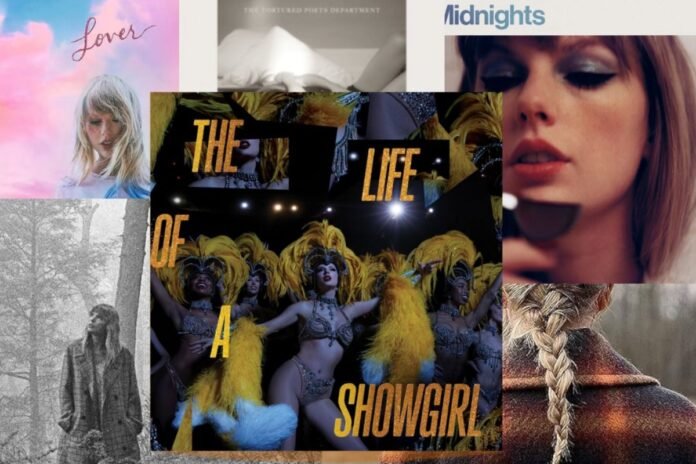From reclaiming her masters to dominating the album charts, Taylor Swift’s post-2019 albums aren’t simply musical eras—they is perhaps items of a a lot bigger puzzle.
Beginning with Lover and probably concluding with the newly launched The Lifetime of a Showgirl, Swift’s latest discography reads much less like a group of information and extra like a coded timeline.
What if these albums aren’t merely about breakups and ballads? What in the event that they’re chapters in a meticulously crafted narrative simply ready to be uncovered? Let’s decode it:
Lover (2019)
The Rebrand Heard ’Around the World
When Lover arrived, it marked greater than a brand new musical period—it launched a brand new Taylor. Gone was the shadowy, revenge-fueled power of Repute, changed by pastels, glitter, and love songs.
However beneath the sugar-coated floor, one thing had shifted. This was her first fully-owned album—an simple energy transfer.
And in taking that management, did she step into a brand new function solely? The tone, branding, and language all felt like a reintroduction—possibly even a comfortable reboot.
Folklore (2020)
The Nice Disappearing Act
Then got here the woods. With Folklore, Swift vanished from pop’s predominant stage and right into a quiet, introspective world of fictional characters, ghost tales, and piano ballads.
The pivot wasn’t simply stylistic—it felt like an escape. Was it creative freedom? Or one thing stranger? The surreal tone and narrative layering stood out—and all throughout a yr when the world itself felt… unreal.
Evermore (2020)
The Mirror World Awakens
Folklore had a “sister,” and Evermore expanded that universe. However this wasn’t a sequel—it was a mirrored image.
Was Swift analyzing alternate variations of herself? Or signaling one thing stirring beneath the floor? This wasn’t simply storytelling anymore. It was world-building. Delusion-making.
And followers began to marvel: is that this Taylor reflecting—or being mirrored?
Midnights (2022)
The Hour All the things Modified
With Midnights, she returned to pop—however one thing was totally different. The album dripped with symbolism: mirrors, clocks, constellations, and callbacks.
“It’s me, hello, I’m the issue…” felt like each confession and omen. Midnight isn’t only a time—it’s a threshold. And Swift appeared to be standing on the fringe of one thing.
The lyrics hinted at metamorphosis, secrets and techniques, and unsettling truths. Was this the turning level?
The Tortured Poets Division (2024)
The Album That Was By no means Simply an Album
TPD was lengthy. Lyrically dense. Laced with names, references, and the texture of somebody airing personal letters.
However this didn’t appear written for herself—it felt aimed toward somebody. Or some group. Critics referred to as it indulgent; followers referred to as it a cipher. A blueprint. A map tracing again to Lover.
Both method, this felt like a keystone. The purpose the place subtext turned textual content—for those who had been watching carefully.
The Lifetime of a Showgirl (2025)
The Final Masks Comes Off
Now comes The Lifetime of a Showgirl. The title alone speaks of efficiency, phantasm, and identification.
Is that this Swift reclaiming her narrative once more—or taking a closing bow earlier than the subsequent transformation? The thought of a showgirl—without end performing, by no means totally seen—carries a haunting weight.
As followers dissect the visuals and lyrics, the query isn’t simply who’s Taylor now? However was she ever who we thought she was?
The Hidden Narrative
Are we studying an excessive amount of into it? Possibly. Or possibly Swift is weaving a narrative solely her most observant listeners can unravel.
Over six albums, there’s been a transparent evolution—not simply in sound, however in theme, tone, and identification. Some followers consider it’s all a part of one grand arc—a secret narrative unfolding in actual time.
Regardless of the case, one factor is for certain: Taylor Swift isn’t simply making music anymore. She’s constructing fantasy.
And the ultimate chapter might already be in movement.
Look again at nostalgic photographs of a younger Taylor Swift at first of her profession within the mid-to-late 2000s.


![Magdalena Bay turned Hollywood Endlessly Cemetery into their psychedelic canvas [Event Review] Magdalena Bay turned Hollywood Forever Cemetery into their psychedelic canvas [Event Review]](https://ipromiseyoumedia.com/wp-content/uploads/2025/10/Screenshot-2025-10-03-at-10.45.22-PM-218x150.png)

